Critical Evaluation of Pakistan's EIA System: A Comparative Study
VerifiedAdded on 2020/04/21
|11
|2494
|219
Report
AI Summary
This report provides a critical evaluation of the Environmental Impact Assessment (EIA) system in Pakistan. It begins by defining EIA and its importance, then traces the history of environmental protection in Pakistan, including the evolution of the Pakistan Environmental Protection Act (PEPA). The report outlines the EIA process in Pakistan, including scoping, screening, and decision-making, and compares it with the EIA process in Australia, highlighting differences in methods and procedural steps. The analysis draws on the Christopher Wood Model to assess the legal, political, and administrative contexts influencing EIA effectiveness. The report also examines the roles of various stakeholders and the importance of public participation. The conclusion emphasizes the need for improvements in Pakistan's EIA process, including training programs and more efficient methods, to ensure effective environmental protection. This report aims to provide a comprehensive overview of Pakistan's EIA system, offering valuable insights for environmental professionals and policymakers. The report has been contributed by a student and is available on Desklib, a platform providing AI-powered study tools and resources.
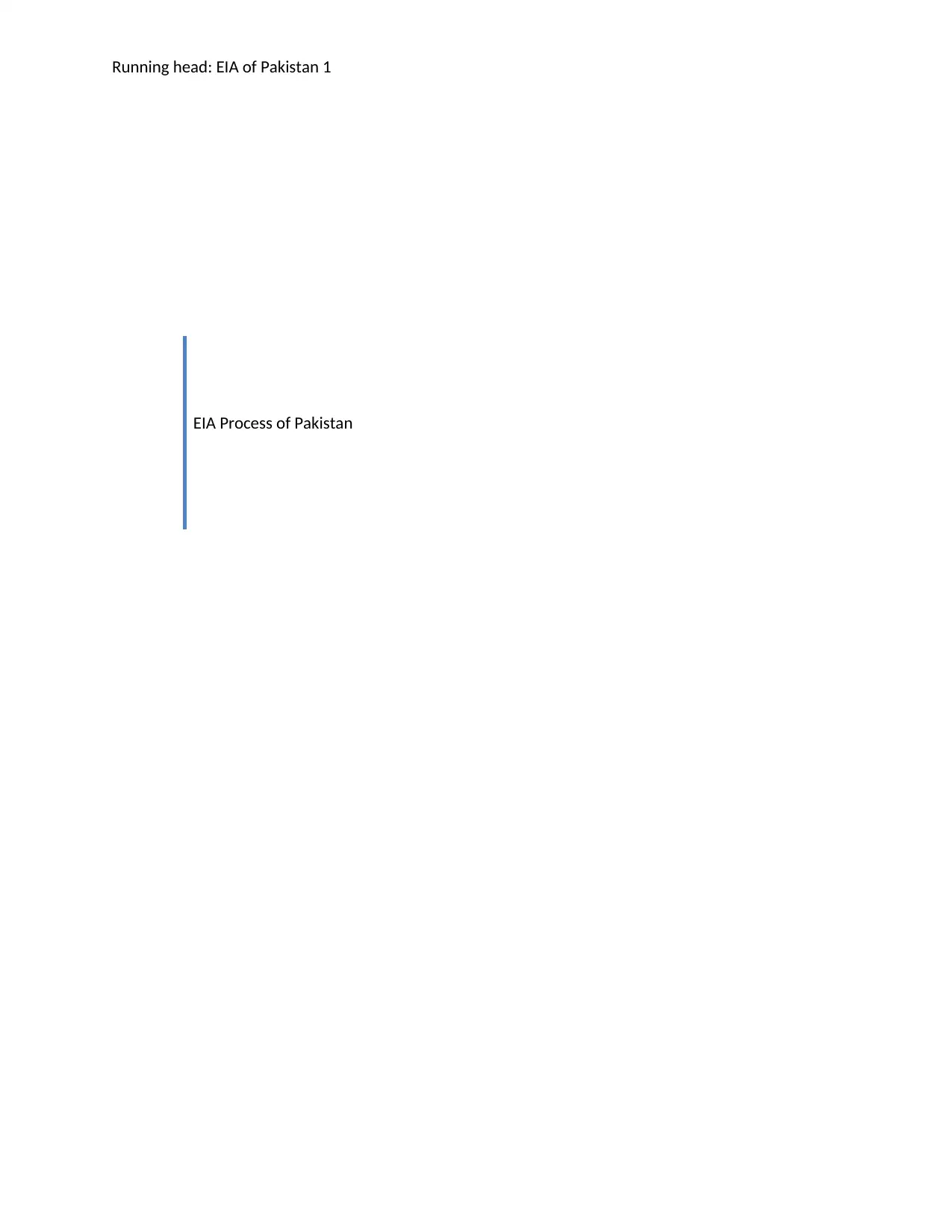
Running head: EIA of Pakistan 1
EIA Process of Pakistan
EIA Process of Pakistan
Paraphrase This Document
Need a fresh take? Get an instant paraphrase of this document with our AI Paraphraser
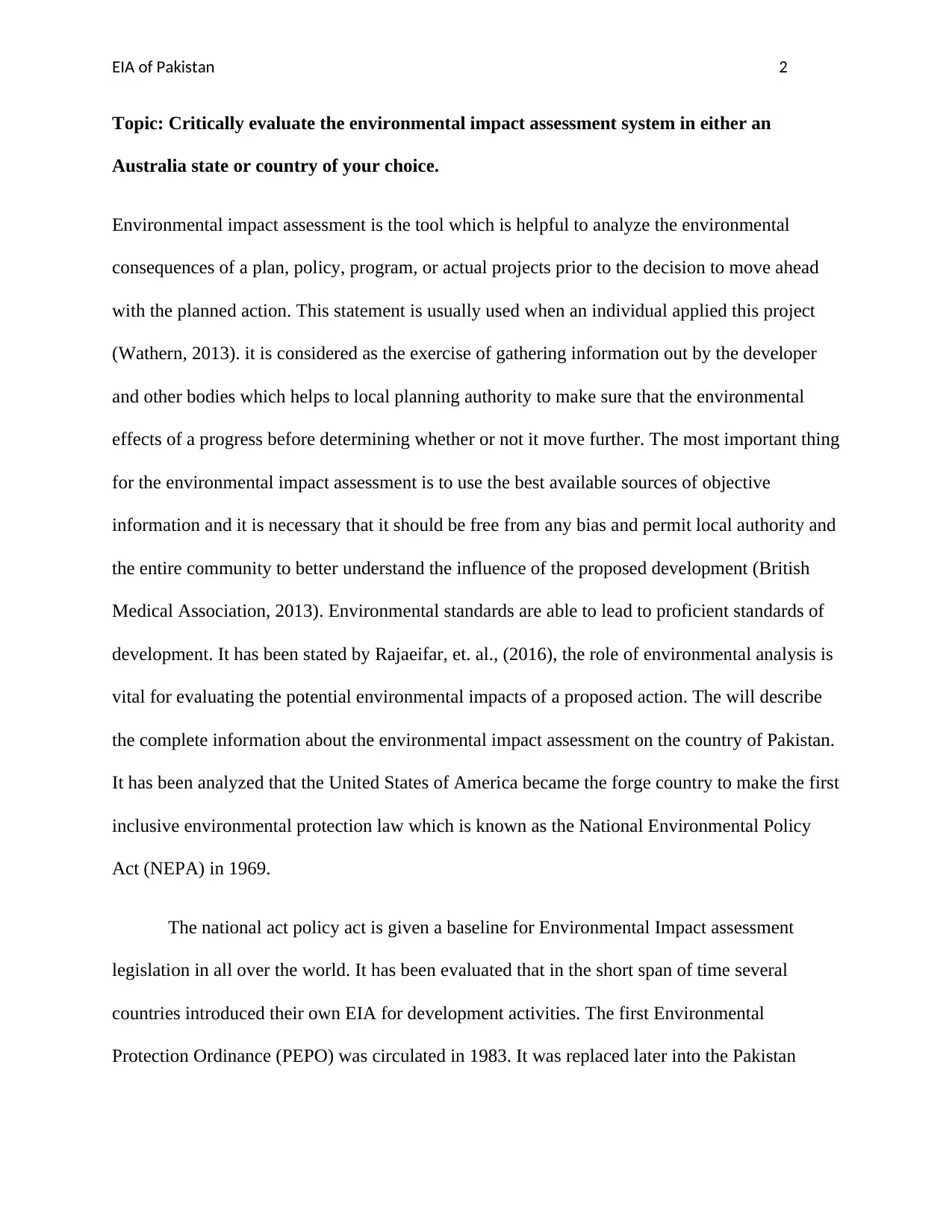
EIA of Pakistan 2
Topic: Critically evaluate the environmental impact assessment system in either an
Australia state or country of your choice.
Environmental impact assessment is the tool which is helpful to analyze the environmental
consequences of a plan, policy, program, or actual projects prior to the decision to move ahead
with the planned action. This statement is usually used when an individual applied this project
(Wathern, 2013). it is considered as the exercise of gathering information out by the developer
and other bodies which helps to local planning authority to make sure that the environmental
effects of a progress before determining whether or not it move further. The most important thing
for the environmental impact assessment is to use the best available sources of objective
information and it is necessary that it should be free from any bias and permit local authority and
the entire community to better understand the influence of the proposed development (British
Medical Association, 2013). Environmental standards are able to lead to proficient standards of
development. It has been stated by Rajaeifar, et. al., (2016), the role of environmental analysis is
vital for evaluating the potential environmental impacts of a proposed action. The will describe
the complete information about the environmental impact assessment on the country of Pakistan.
It has been analyzed that the United States of America became the forge country to make the first
inclusive environmental protection law which is known as the National Environmental Policy
Act (NEPA) in 1969.
The national act policy act is given a baseline for Environmental Impact assessment
legislation in all over the world. It has been evaluated that in the short span of time several
countries introduced their own EIA for development activities. The first Environmental
Protection Ordinance (PEPO) was circulated in 1983. It was replaced later into the Pakistan
Topic: Critically evaluate the environmental impact assessment system in either an
Australia state or country of your choice.
Environmental impact assessment is the tool which is helpful to analyze the environmental
consequences of a plan, policy, program, or actual projects prior to the decision to move ahead
with the planned action. This statement is usually used when an individual applied this project
(Wathern, 2013). it is considered as the exercise of gathering information out by the developer
and other bodies which helps to local planning authority to make sure that the environmental
effects of a progress before determining whether or not it move further. The most important thing
for the environmental impact assessment is to use the best available sources of objective
information and it is necessary that it should be free from any bias and permit local authority and
the entire community to better understand the influence of the proposed development (British
Medical Association, 2013). Environmental standards are able to lead to proficient standards of
development. It has been stated by Rajaeifar, et. al., (2016), the role of environmental analysis is
vital for evaluating the potential environmental impacts of a proposed action. The will describe
the complete information about the environmental impact assessment on the country of Pakistan.
It has been analyzed that the United States of America became the forge country to make the first
inclusive environmental protection law which is known as the National Environmental Policy
Act (NEPA) in 1969.
The national act policy act is given a baseline for Environmental Impact assessment
legislation in all over the world. It has been evaluated that in the short span of time several
countries introduced their own EIA for development activities. The first Environmental
Protection Ordinance (PEPO) was circulated in 1983. It was replaced later into the Pakistan
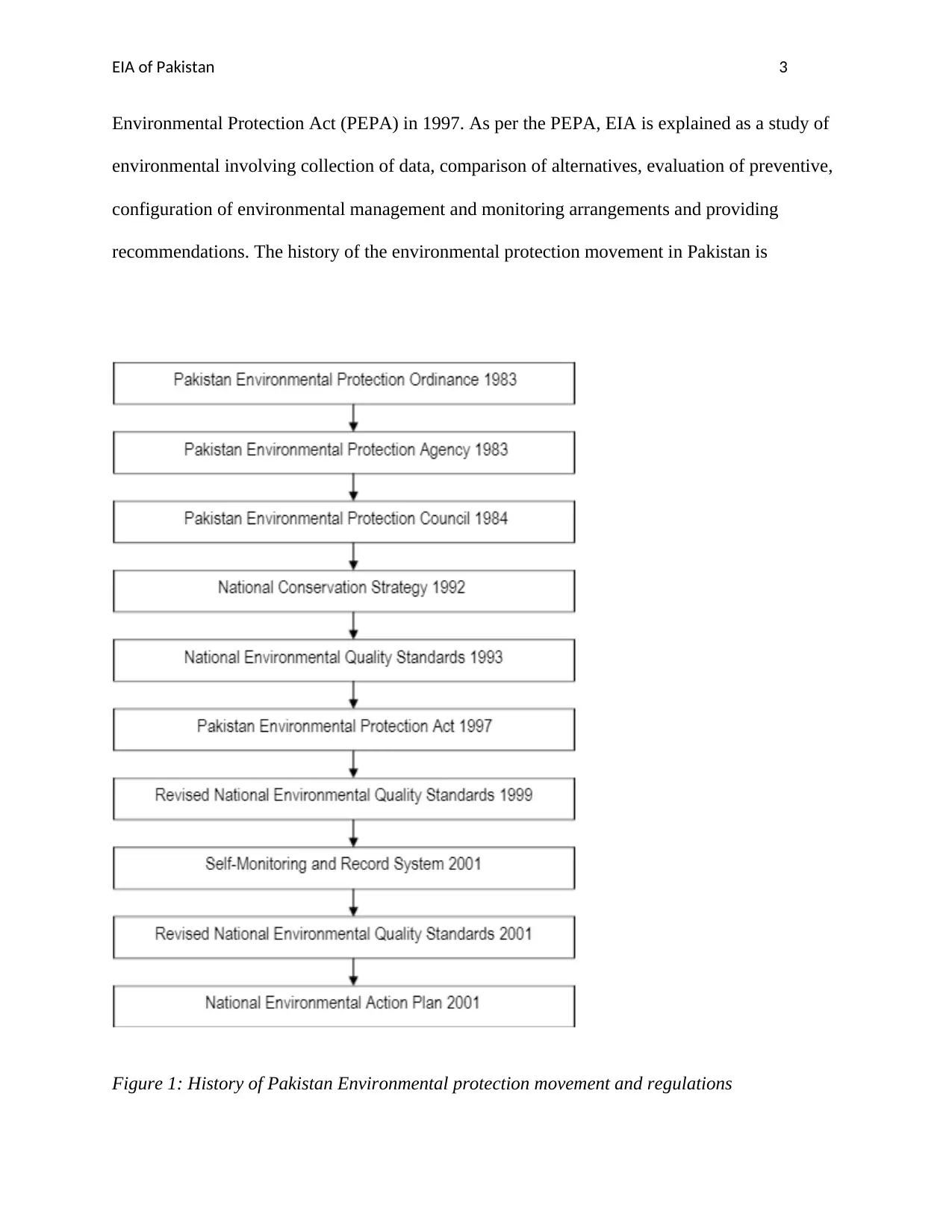
EIA of Pakistan 3
Environmental Protection Act (PEPA) in 1997. As per the PEPA, EIA is explained as a study of
environmental involving collection of data, comparison of alternatives, evaluation of preventive,
configuration of environmental management and monitoring arrangements and providing
recommendations. The history of the environmental protection movement in Pakistan is
Figure 1: History of Pakistan Environmental protection movement and regulations
Environmental Protection Act (PEPA) in 1997. As per the PEPA, EIA is explained as a study of
environmental involving collection of data, comparison of alternatives, evaluation of preventive,
configuration of environmental management and monitoring arrangements and providing
recommendations. The history of the environmental protection movement in Pakistan is
Figure 1: History of Pakistan Environmental protection movement and regulations
⊘ This is a preview!⊘
Do you want full access?
Subscribe today to unlock all pages.

Trusted by 1+ million students worldwide
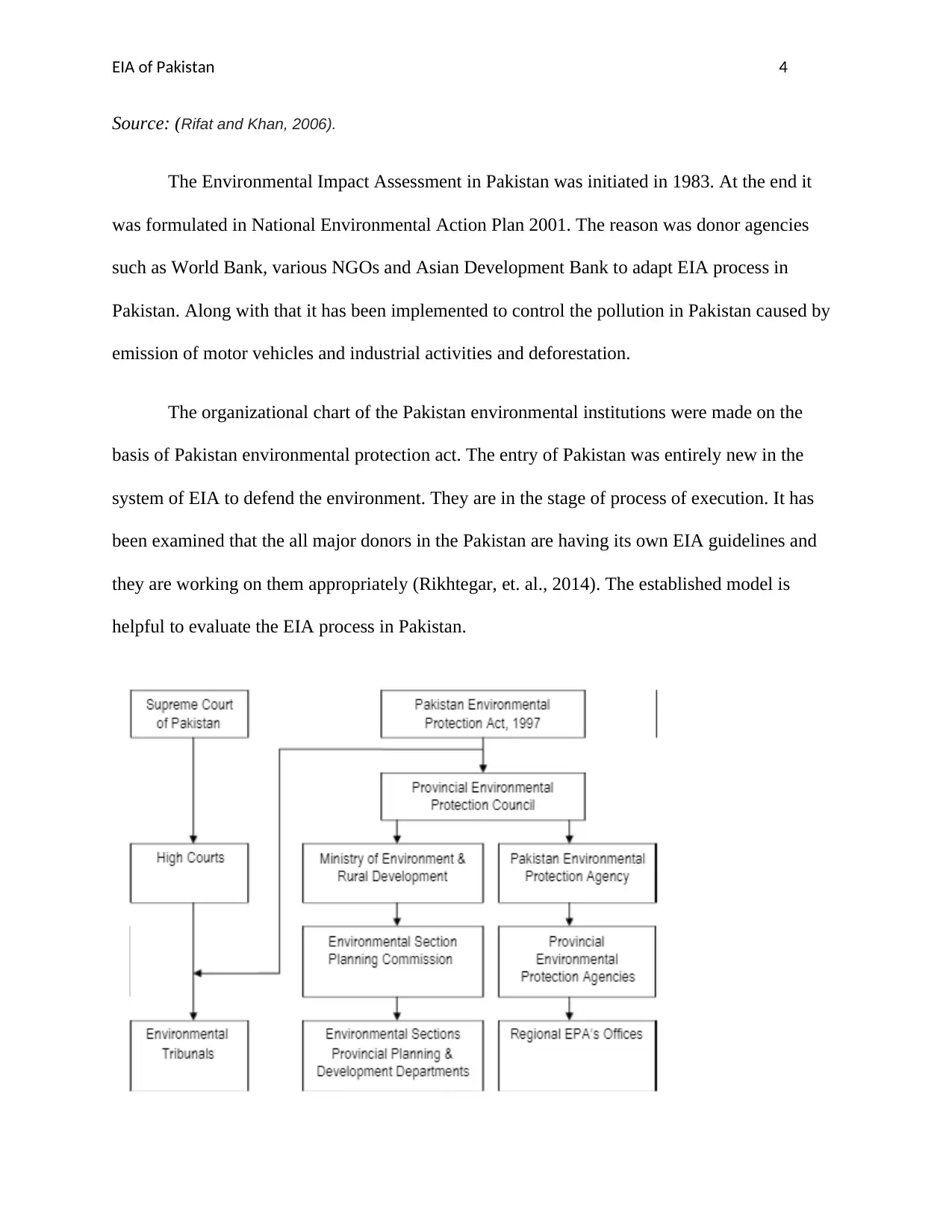
EIA of Pakistan 4
Source: (Rifat and Khan, 2006).
The Environmental Impact Assessment in Pakistan was initiated in 1983. At the end it
was formulated in National Environmental Action Plan 2001. The reason was donor agencies
such as World Bank, various NGOs and Asian Development Bank to adapt EIA process in
Pakistan. Along with that it has been implemented to control the pollution in Pakistan caused by
emission of motor vehicles and industrial activities and deforestation.
The organizational chart of the Pakistan environmental institutions were made on the
basis of Pakistan environmental protection act. The entry of Pakistan was entirely new in the
system of EIA to defend the environment. They are in the stage of process of execution. It has
been examined that the all major donors in the Pakistan are having its own EIA guidelines and
they are working on them appropriately (Rikhtegar, et. al., 2014). The established model is
helpful to evaluate the EIA process in Pakistan.
Source: (Rifat and Khan, 2006).
The Environmental Impact Assessment in Pakistan was initiated in 1983. At the end it
was formulated in National Environmental Action Plan 2001. The reason was donor agencies
such as World Bank, various NGOs and Asian Development Bank to adapt EIA process in
Pakistan. Along with that it has been implemented to control the pollution in Pakistan caused by
emission of motor vehicles and industrial activities and deforestation.
The organizational chart of the Pakistan environmental institutions were made on the
basis of Pakistan environmental protection act. The entry of Pakistan was entirely new in the
system of EIA to defend the environment. They are in the stage of process of execution. It has
been examined that the all major donors in the Pakistan are having its own EIA guidelines and
they are working on them appropriately (Rikhtegar, et. al., 2014). The established model is
helpful to evaluate the EIA process in Pakistan.
Paraphrase This Document
Need a fresh take? Get an instant paraphrase of this document with our AI Paraphraser
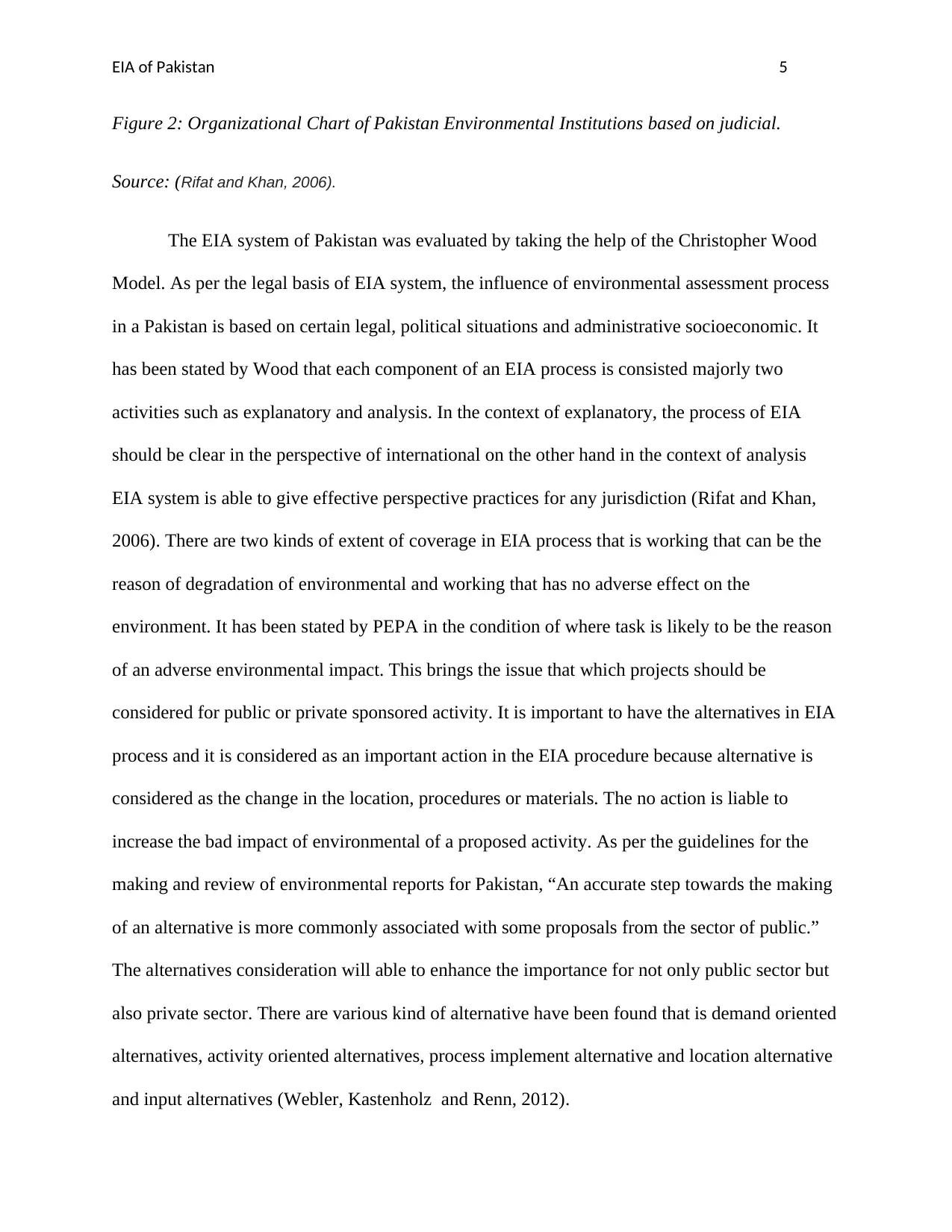
EIA of Pakistan 5
Figure 2: Organizational Chart of Pakistan Environmental Institutions based on judicial.
Source: (Rifat and Khan, 2006).
The EIA system of Pakistan was evaluated by taking the help of the Christopher Wood
Model. As per the legal basis of EIA system, the influence of environmental assessment process
in a Pakistan is based on certain legal, political situations and administrative socioeconomic. It
has been stated by Wood that each component of an EIA process is consisted majorly two
activities such as explanatory and analysis. In the context of explanatory, the process of EIA
should be clear in the perspective of international on the other hand in the context of analysis
EIA system is able to give effective perspective practices for any jurisdiction (Rifat and Khan,
2006). There are two kinds of extent of coverage in EIA process that is working that can be the
reason of degradation of environmental and working that has no adverse effect on the
environment. It has been stated by PEPA in the condition of where task is likely to be the reason
of an adverse environmental impact. This brings the issue that which projects should be
considered for public or private sponsored activity. It is important to have the alternatives in EIA
process and it is considered as an important action in the EIA procedure because alternative is
considered as the change in the location, procedures or materials. The no action is liable to
increase the bad impact of environmental of a proposed activity. As per the guidelines for the
making and review of environmental reports for Pakistan, “An accurate step towards the making
of an alternative is more commonly associated with some proposals from the sector of public.”
The alternatives consideration will able to enhance the importance for not only public sector but
also private sector. There are various kind of alternative have been found that is demand oriented
alternatives, activity oriented alternatives, process implement alternative and location alternative
and input alternatives (Webler, Kastenholz and Renn, 2012).
Figure 2: Organizational Chart of Pakistan Environmental Institutions based on judicial.
Source: (Rifat and Khan, 2006).
The EIA system of Pakistan was evaluated by taking the help of the Christopher Wood
Model. As per the legal basis of EIA system, the influence of environmental assessment process
in a Pakistan is based on certain legal, political situations and administrative socioeconomic. It
has been stated by Wood that each component of an EIA process is consisted majorly two
activities such as explanatory and analysis. In the context of explanatory, the process of EIA
should be clear in the perspective of international on the other hand in the context of analysis
EIA system is able to give effective perspective practices for any jurisdiction (Rifat and Khan,
2006). There are two kinds of extent of coverage in EIA process that is working that can be the
reason of degradation of environmental and working that has no adverse effect on the
environment. It has been stated by PEPA in the condition of where task is likely to be the reason
of an adverse environmental impact. This brings the issue that which projects should be
considered for public or private sponsored activity. It is important to have the alternatives in EIA
process and it is considered as an important action in the EIA procedure because alternative is
considered as the change in the location, procedures or materials. The no action is liable to
increase the bad impact of environmental of a proposed activity. As per the guidelines for the
making and review of environmental reports for Pakistan, “An accurate step towards the making
of an alternative is more commonly associated with some proposals from the sector of public.”
The alternatives consideration will able to enhance the importance for not only public sector but
also private sector. There are various kind of alternative have been found that is demand oriented
alternatives, activity oriented alternatives, process implement alternative and location alternative
and input alternatives (Webler, Kastenholz and Renn, 2012).
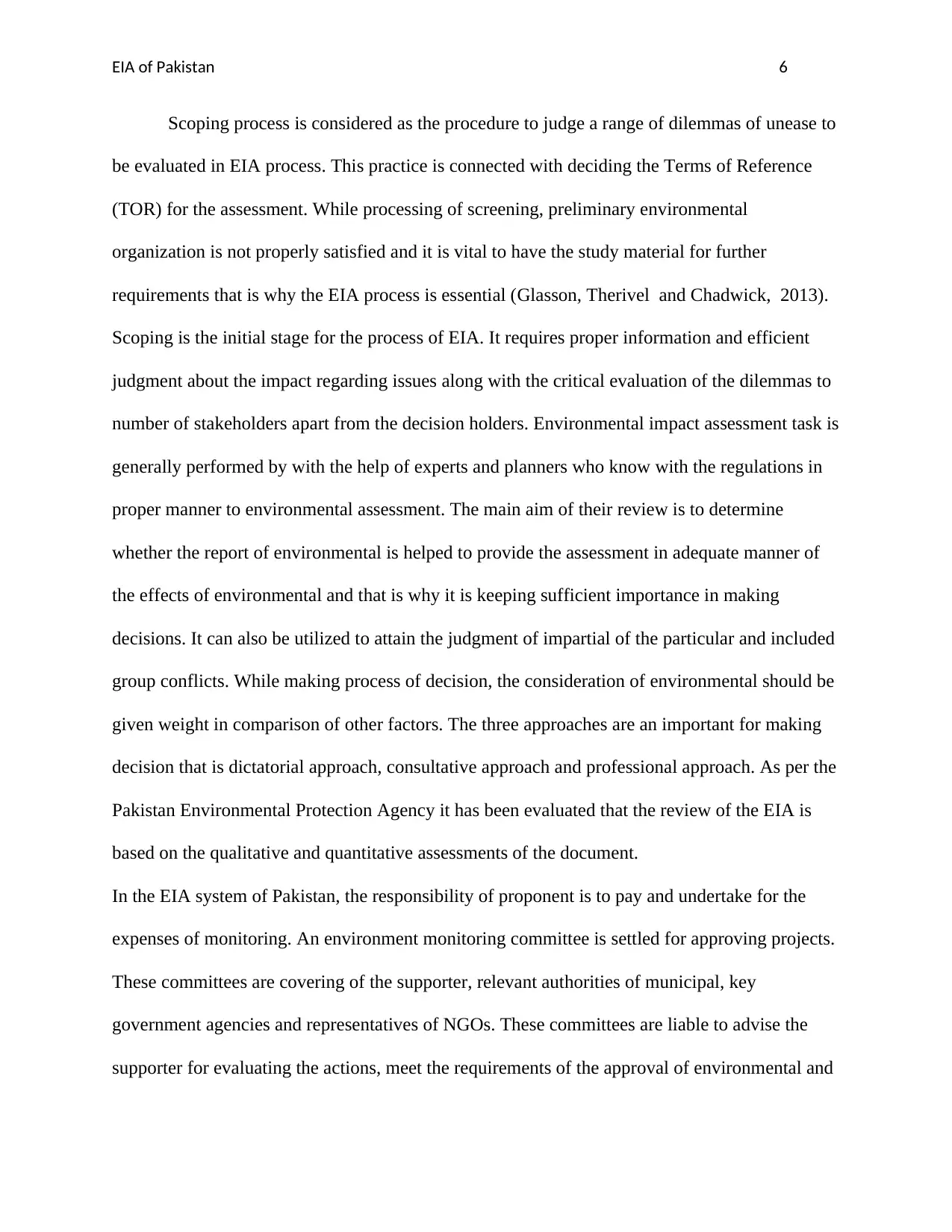
EIA of Pakistan 6
Scoping process is considered as the procedure to judge a range of dilemmas of unease to
be evaluated in EIA process. This practice is connected with deciding the Terms of Reference
(TOR) for the assessment. While processing of screening, preliminary environmental
organization is not properly satisfied and it is vital to have the study material for further
requirements that is why the EIA process is essential (Glasson, Therivel and Chadwick, 2013).
Scoping is the initial stage for the process of EIA. It requires proper information and efficient
judgment about the impact regarding issues along with the critical evaluation of the dilemmas to
number of stakeholders apart from the decision holders. Environmental impact assessment task is
generally performed by with the help of experts and planners who know with the regulations in
proper manner to environmental assessment. The main aim of their review is to determine
whether the report of environmental is helped to provide the assessment in adequate manner of
the effects of environmental and that is why it is keeping sufficient importance in making
decisions. It can also be utilized to attain the judgment of impartial of the particular and included
group conflicts. While making process of decision, the consideration of environmental should be
given weight in comparison of other factors. The three approaches are an important for making
decision that is dictatorial approach, consultative approach and professional approach. As per the
Pakistan Environmental Protection Agency it has been evaluated that the review of the EIA is
based on the qualitative and quantitative assessments of the document.
In the EIA system of Pakistan, the responsibility of proponent is to pay and undertake for the
expenses of monitoring. An environment monitoring committee is settled for approving projects.
These committees are covering of the supporter, relevant authorities of municipal, key
government agencies and representatives of NGOs. These committees are liable to advise the
supporter for evaluating the actions, meet the requirements of the approval of environmental and
Scoping process is considered as the procedure to judge a range of dilemmas of unease to
be evaluated in EIA process. This practice is connected with deciding the Terms of Reference
(TOR) for the assessment. While processing of screening, preliminary environmental
organization is not properly satisfied and it is vital to have the study material for further
requirements that is why the EIA process is essential (Glasson, Therivel and Chadwick, 2013).
Scoping is the initial stage for the process of EIA. It requires proper information and efficient
judgment about the impact regarding issues along with the critical evaluation of the dilemmas to
number of stakeholders apart from the decision holders. Environmental impact assessment task is
generally performed by with the help of experts and planners who know with the regulations in
proper manner to environmental assessment. The main aim of their review is to determine
whether the report of environmental is helped to provide the assessment in adequate manner of
the effects of environmental and that is why it is keeping sufficient importance in making
decisions. It can also be utilized to attain the judgment of impartial of the particular and included
group conflicts. While making process of decision, the consideration of environmental should be
given weight in comparison of other factors. The three approaches are an important for making
decision that is dictatorial approach, consultative approach and professional approach. As per the
Pakistan Environmental Protection Agency it has been evaluated that the review of the EIA is
based on the qualitative and quantitative assessments of the document.
In the EIA system of Pakistan, the responsibility of proponent is to pay and undertake for the
expenses of monitoring. An environment monitoring committee is settled for approving projects.
These committees are covering of the supporter, relevant authorities of municipal, key
government agencies and representatives of NGOs. These committees are liable to advise the
supporter for evaluating the actions, meet the requirements of the approval of environmental and
⊘ This is a preview!⊘
Do you want full access?
Subscribe today to unlock all pages.

Trusted by 1+ million students worldwide
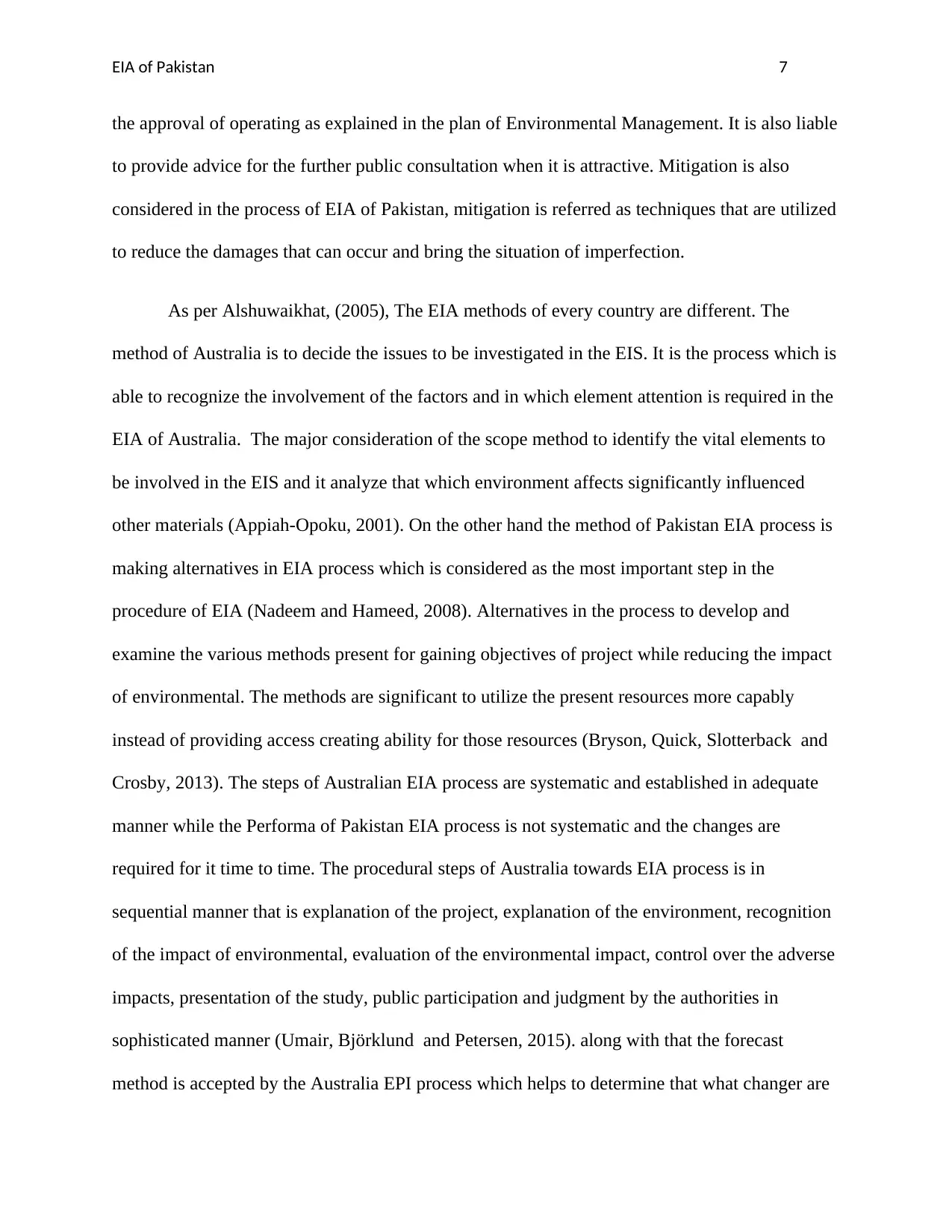
EIA of Pakistan 7
the approval of operating as explained in the plan of Environmental Management. It is also liable
to provide advice for the further public consultation when it is attractive. Mitigation is also
considered in the process of EIA of Pakistan, mitigation is referred as techniques that are utilized
to reduce the damages that can occur and bring the situation of imperfection.
As per Alshuwaikhat, (2005), The EIA methods of every country are different. The
method of Australia is to decide the issues to be investigated in the EIS. It is the process which is
able to recognize the involvement of the factors and in which element attention is required in the
EIA of Australia. The major consideration of the scope method to identify the vital elements to
be involved in the EIS and it analyze that which environment affects significantly influenced
other materials (Appiah-Opoku, 2001). On the other hand the method of Pakistan EIA process is
making alternatives in EIA process which is considered as the most important step in the
procedure of EIA (Nadeem and Hameed, 2008). Alternatives in the process to develop and
examine the various methods present for gaining objectives of project while reducing the impact
of environmental. The methods are significant to utilize the present resources more capably
instead of providing access creating ability for those resources (Bryson, Quick, Slotterback and
Crosby, 2013). The steps of Australian EIA process are systematic and established in adequate
manner while the Performa of Pakistan EIA process is not systematic and the changes are
required for it time to time. The procedural steps of Australia towards EIA process is in
sequential manner that is explanation of the project, explanation of the environment, recognition
of the impact of environmental, evaluation of the environmental impact, control over the adverse
impacts, presentation of the study, public participation and judgment by the authorities in
sophisticated manner (Umair, Björklund and Petersen, 2015). along with that the forecast
method is accepted by the Australia EPI process which helps to determine that what changer are
the approval of operating as explained in the plan of Environmental Management. It is also liable
to provide advice for the further public consultation when it is attractive. Mitigation is also
considered in the process of EIA of Pakistan, mitigation is referred as techniques that are utilized
to reduce the damages that can occur and bring the situation of imperfection.
As per Alshuwaikhat, (2005), The EIA methods of every country are different. The
method of Australia is to decide the issues to be investigated in the EIS. It is the process which is
able to recognize the involvement of the factors and in which element attention is required in the
EIA of Australia. The major consideration of the scope method to identify the vital elements to
be involved in the EIS and it analyze that which environment affects significantly influenced
other materials (Appiah-Opoku, 2001). On the other hand the method of Pakistan EIA process is
making alternatives in EIA process which is considered as the most important step in the
procedure of EIA (Nadeem and Hameed, 2008). Alternatives in the process to develop and
examine the various methods present for gaining objectives of project while reducing the impact
of environmental. The methods are significant to utilize the present resources more capably
instead of providing access creating ability for those resources (Bryson, Quick, Slotterback and
Crosby, 2013). The steps of Australian EIA process are systematic and established in adequate
manner while the Performa of Pakistan EIA process is not systematic and the changes are
required for it time to time. The procedural steps of Australia towards EIA process is in
sequential manner that is explanation of the project, explanation of the environment, recognition
of the impact of environmental, evaluation of the environmental impact, control over the adverse
impacts, presentation of the study, public participation and judgment by the authorities in
sophisticated manner (Umair, Björklund and Petersen, 2015). along with that the forecast
method is accepted by the Australia EPI process which helps to determine that what changer are
Paraphrase This Document
Need a fresh take? Get an instant paraphrase of this document with our AI Paraphraser
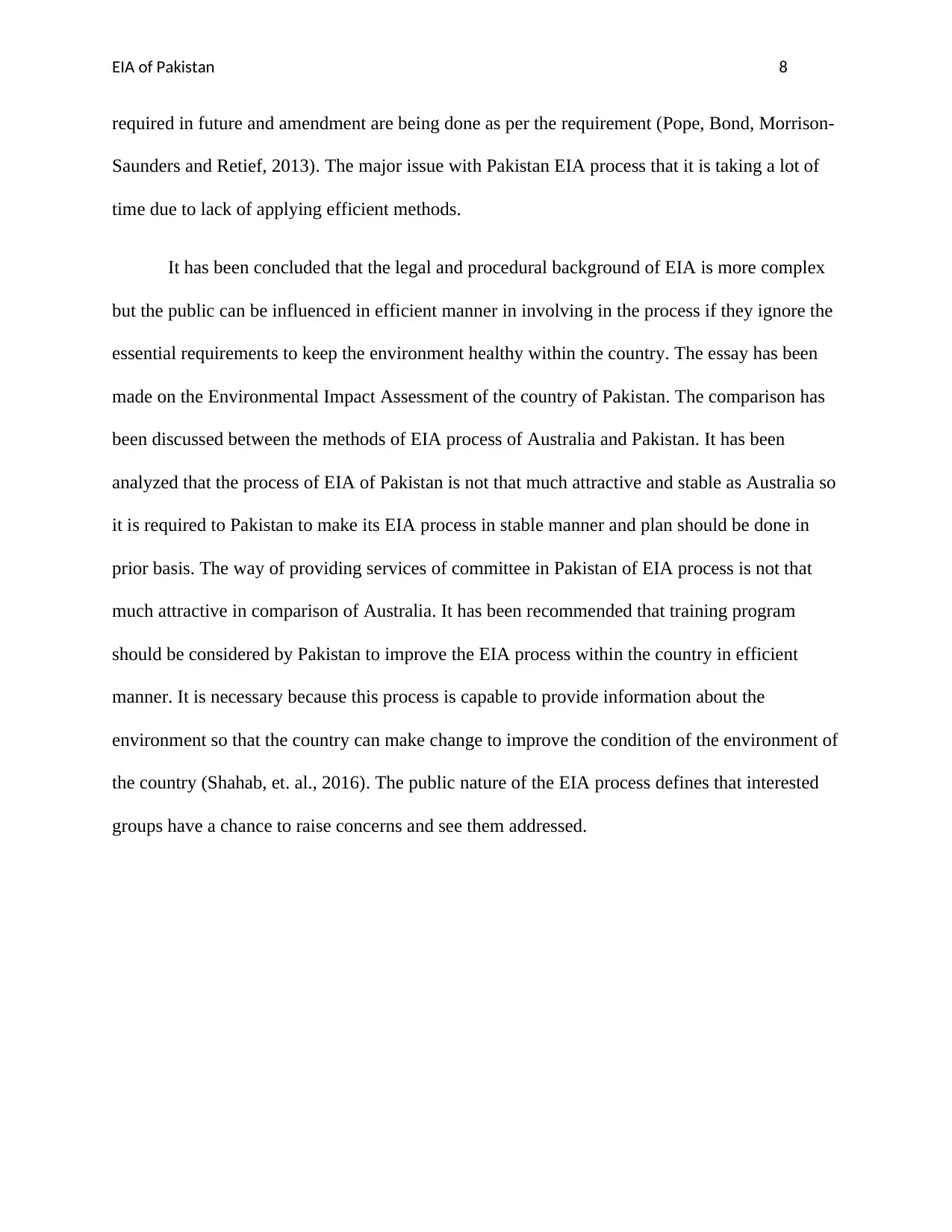
EIA of Pakistan 8
required in future and amendment are being done as per the requirement (Pope, Bond, Morrison-
Saunders and Retief, 2013). The major issue with Pakistan EIA process that it is taking a lot of
time due to lack of applying efficient methods.
It has been concluded that the legal and procedural background of EIA is more complex
but the public can be influenced in efficient manner in involving in the process if they ignore the
essential requirements to keep the environment healthy within the country. The essay has been
made on the Environmental Impact Assessment of the country of Pakistan. The comparison has
been discussed between the methods of EIA process of Australia and Pakistan. It has been
analyzed that the process of EIA of Pakistan is not that much attractive and stable as Australia so
it is required to Pakistan to make its EIA process in stable manner and plan should be done in
prior basis. The way of providing services of committee in Pakistan of EIA process is not that
much attractive in comparison of Australia. It has been recommended that training program
should be considered by Pakistan to improve the EIA process within the country in efficient
manner. It is necessary because this process is capable to provide information about the
environment so that the country can make change to improve the condition of the environment of
the country (Shahab, et. al., 2016). The public nature of the EIA process defines that interested
groups have a chance to raise concerns and see them addressed.
required in future and amendment are being done as per the requirement (Pope, Bond, Morrison-
Saunders and Retief, 2013). The major issue with Pakistan EIA process that it is taking a lot of
time due to lack of applying efficient methods.
It has been concluded that the legal and procedural background of EIA is more complex
but the public can be influenced in efficient manner in involving in the process if they ignore the
essential requirements to keep the environment healthy within the country. The essay has been
made on the Environmental Impact Assessment of the country of Pakistan. The comparison has
been discussed between the methods of EIA process of Australia and Pakistan. It has been
analyzed that the process of EIA of Pakistan is not that much attractive and stable as Australia so
it is required to Pakistan to make its EIA process in stable manner and plan should be done in
prior basis. The way of providing services of committee in Pakistan of EIA process is not that
much attractive in comparison of Australia. It has been recommended that training program
should be considered by Pakistan to improve the EIA process within the country in efficient
manner. It is necessary because this process is capable to provide information about the
environment so that the country can make change to improve the condition of the environment of
the country (Shahab, et. al., 2016). The public nature of the EIA process defines that interested
groups have a chance to raise concerns and see them addressed.
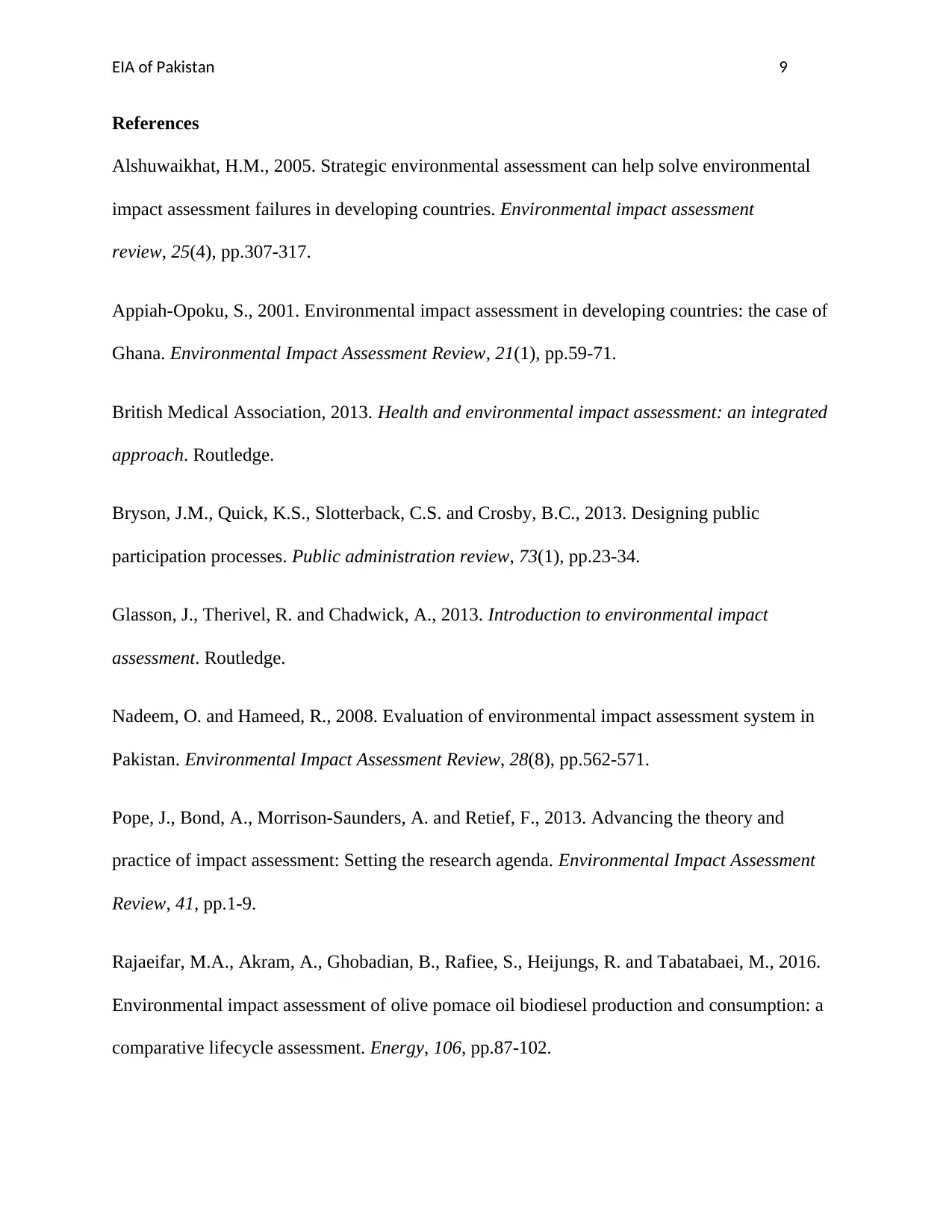
EIA of Pakistan 9
References
Alshuwaikhat, H.M., 2005. Strategic environmental assessment can help solve environmental
impact assessment failures in developing countries. Environmental impact assessment
review, 25(4), pp.307-317.
Appiah-Opoku, S., 2001. Environmental impact assessment in developing countries: the case of
Ghana. Environmental Impact Assessment Review, 21(1), pp.59-71.
British Medical Association, 2013. Health and environmental impact assessment: an integrated
approach. Routledge.
Bryson, J.M., Quick, K.S., Slotterback, C.S. and Crosby, B.C., 2013. Designing public
participation processes. Public administration review, 73(1), pp.23-34.
Glasson, J., Therivel, R. and Chadwick, A., 2013. Introduction to environmental impact
assessment. Routledge.
Nadeem, O. and Hameed, R., 2008. Evaluation of environmental impact assessment system in
Pakistan. Environmental Impact Assessment Review, 28(8), pp.562-571.
Pope, J., Bond, A., Morrison-Saunders, A. and Retief, F., 2013. Advancing the theory and
practice of impact assessment: Setting the research agenda. Environmental Impact Assessment
Review, 41, pp.1-9.
Rajaeifar, M.A., Akram, A., Ghobadian, B., Rafiee, S., Heijungs, R. and Tabatabaei, M., 2016.
Environmental impact assessment of olive pomace oil biodiesel production and consumption: a
comparative lifecycle assessment. Energy, 106, pp.87-102.
References
Alshuwaikhat, H.M., 2005. Strategic environmental assessment can help solve environmental
impact assessment failures in developing countries. Environmental impact assessment
review, 25(4), pp.307-317.
Appiah-Opoku, S., 2001. Environmental impact assessment in developing countries: the case of
Ghana. Environmental Impact Assessment Review, 21(1), pp.59-71.
British Medical Association, 2013. Health and environmental impact assessment: an integrated
approach. Routledge.
Bryson, J.M., Quick, K.S., Slotterback, C.S. and Crosby, B.C., 2013. Designing public
participation processes. Public administration review, 73(1), pp.23-34.
Glasson, J., Therivel, R. and Chadwick, A., 2013. Introduction to environmental impact
assessment. Routledge.
Nadeem, O. and Hameed, R., 2008. Evaluation of environmental impact assessment system in
Pakistan. Environmental Impact Assessment Review, 28(8), pp.562-571.
Pope, J., Bond, A., Morrison-Saunders, A. and Retief, F., 2013. Advancing the theory and
practice of impact assessment: Setting the research agenda. Environmental Impact Assessment
Review, 41, pp.1-9.
Rajaeifar, M.A., Akram, A., Ghobadian, B., Rafiee, S., Heijungs, R. and Tabatabaei, M., 2016.
Environmental impact assessment of olive pomace oil biodiesel production and consumption: a
comparative lifecycle assessment. Energy, 106, pp.87-102.
⊘ This is a preview!⊘
Do you want full access?
Subscribe today to unlock all pages.

Trusted by 1+ million students worldwide
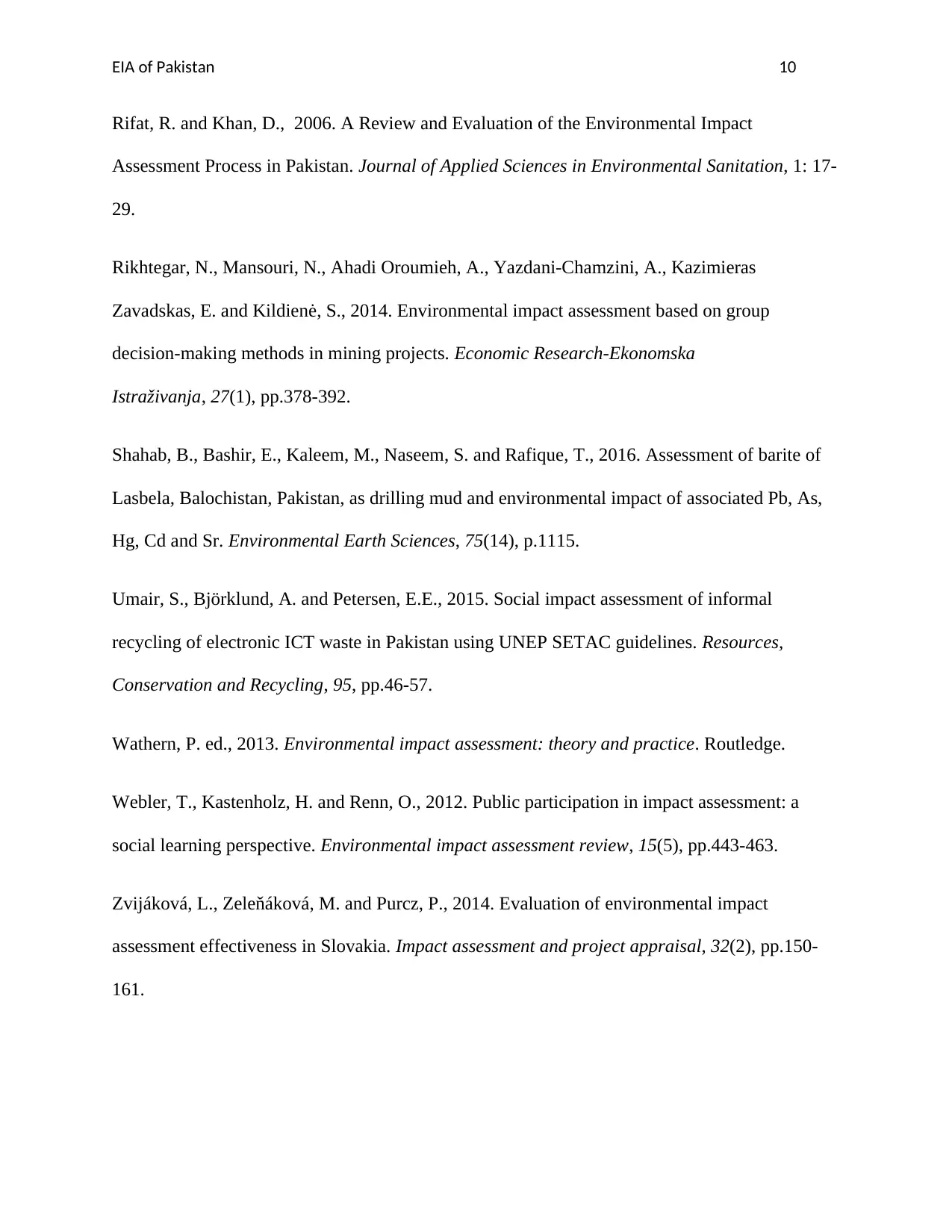
EIA of Pakistan 10
Rifat, R. and Khan, D., 2006. A Review and Evaluation of the Environmental Impact
Assessment Process in Pakistan. Journal of Applied Sciences in Environmental Sanitation, 1: 17-
29.
Rikhtegar, N., Mansouri, N., Ahadi Oroumieh, A., Yazdani-Chamzini, A., Kazimieras
Zavadskas, E. and Kildienė, S., 2014. Environmental impact assessment based on group
decision-making methods in mining projects. Economic Research-Ekonomska
Istraživanja, 27(1), pp.378-392.
Shahab, B., Bashir, E., Kaleem, M., Naseem, S. and Rafique, T., 2016. Assessment of barite of
Lasbela, Balochistan, Pakistan, as drilling mud and environmental impact of associated Pb, As,
Hg, Cd and Sr. Environmental Earth Sciences, 75(14), p.1115.
Umair, S., Björklund, A. and Petersen, E.E., 2015. Social impact assessment of informal
recycling of electronic ICT waste in Pakistan using UNEP SETAC guidelines. Resources,
Conservation and Recycling, 95, pp.46-57.
Wathern, P. ed., 2013. Environmental impact assessment: theory and practice. Routledge.
Webler, T., Kastenholz, H. and Renn, O., 2012. Public participation in impact assessment: a
social learning perspective. Environmental impact assessment review, 15(5), pp.443-463.
Zvijáková, L., Zeleňáková, M. and Purcz, P., 2014. Evaluation of environmental impact
assessment effectiveness in Slovakia. Impact assessment and project appraisal, 32(2), pp.150-
161.
Rifat, R. and Khan, D., 2006. A Review and Evaluation of the Environmental Impact
Assessment Process in Pakistan. Journal of Applied Sciences in Environmental Sanitation, 1: 17-
29.
Rikhtegar, N., Mansouri, N., Ahadi Oroumieh, A., Yazdani-Chamzini, A., Kazimieras
Zavadskas, E. and Kildienė, S., 2014. Environmental impact assessment based on group
decision-making methods in mining projects. Economic Research-Ekonomska
Istraživanja, 27(1), pp.378-392.
Shahab, B., Bashir, E., Kaleem, M., Naseem, S. and Rafique, T., 2016. Assessment of barite of
Lasbela, Balochistan, Pakistan, as drilling mud and environmental impact of associated Pb, As,
Hg, Cd and Sr. Environmental Earth Sciences, 75(14), p.1115.
Umair, S., Björklund, A. and Petersen, E.E., 2015. Social impact assessment of informal
recycling of electronic ICT waste in Pakistan using UNEP SETAC guidelines. Resources,
Conservation and Recycling, 95, pp.46-57.
Wathern, P. ed., 2013. Environmental impact assessment: theory and practice. Routledge.
Webler, T., Kastenholz, H. and Renn, O., 2012. Public participation in impact assessment: a
social learning perspective. Environmental impact assessment review, 15(5), pp.443-463.
Zvijáková, L., Zeleňáková, M. and Purcz, P., 2014. Evaluation of environmental impact
assessment effectiveness in Slovakia. Impact assessment and project appraisal, 32(2), pp.150-
161.
Paraphrase This Document
Need a fresh take? Get an instant paraphrase of this document with our AI Paraphraser

EIA of Pakistan 11
1 out of 11
Related Documents
Your All-in-One AI-Powered Toolkit for Academic Success.
+13062052269
info@desklib.com
Available 24*7 on WhatsApp / Email
![[object Object]](/_next/static/media/star-bottom.7253800d.svg)
Unlock your academic potential
Copyright © 2020–2025 A2Z Services. All Rights Reserved. Developed and managed by ZUCOL.





